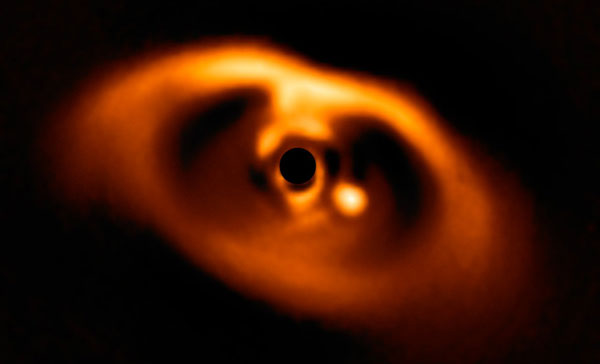Astronomers using a new instrument on the Very Large Telescope in Chile have directly imaged a newborn planet.
Our understanding of planet formation is often shrouded in theoretical models. But now, scientists have directly observed a new planet in the gaseous disk around a young star about 370 light-years from Earth.

ESO / A. Müller et al.
The search for new planets often starts with a survey of the heavenly regions where stars are born. Scientists at the Max Planck Institute for Astronomy (MPIA) in Heidelberg, Germany were doing just that when they focused their attention on the young star PDS 70. First discovered in 1992, the star is about 5 million years old and is still accreting mass from its surrounding disk of gas and dust. Within the gaseous swirl that surrounds it, researchers had previously found a dark gap. But while disk gaps are often taken to be the signature of a newborn planet, the discovery isn’t guaranteed — other processes can create disk gaps, too.
To check on the presence of a planet, scientists used using the Very Large Telescope’s SPHERE adaptive optics and coronagraphic system to see new details in the disk. Once researchers could see the dark path more clearly, they found a point source of light — dubbed PDS 70b — within the disk's large gap, the group reports in Astronomy and Astrophysics.
The team also modeled the object's properties to derive its mass. PDS 70b appears to have between 5 and 9 times Jupiter's mass, which qualifies it as a likely giant planet rather than a brown dwarf.
In a follow-up study, scientists went a step further, taking additional SPHERE-based measurements to study the planet's atmosphere. The gases surrounding the planet have an estimated temperature of about 1000°C, and by analyzing the planet’s spectrum, scientists discovered that the atmosphere probably contains clouds. “Clouds have a different meaning than on Earth,” warns Müller; this planet’s extreme temperatures don’t allow for water condensation. Instead, its clouds might contain ingredients such as iron, sodium sulfite, potassium chloride, or even a magnesium compound called forsterite.
In addition to using new observations, scientists also revisited observations dating back to 2012 in order to track the planet’s location. While doing this, they saw an arc in the protoplanetary disk that was indicative of orbital motion. The team concluded that it takes PDS 70b about 120 years to orbit its star.
The planet is still forming by accumulating material, adds André Müller (MPIA), the second study’s lead author. The present findings “confirm theoretical models, but we need more of these systems to understand the process,” he says.
Trent Dupuy (Gemini Observatory), who was not involved in the study, warns of the “technological challenges of confirming very faint objects next to very bright stars,” which make it difficult to confirm that any point source is a new planet. But he adds: “Overall, I think this extremely exciting.”
 1
1









Comments
Peter Wilson
July 11, 2018 at 1:44 pm
It's so cute!
You must be logged in to post a comment.
You must be logged in to post a comment.